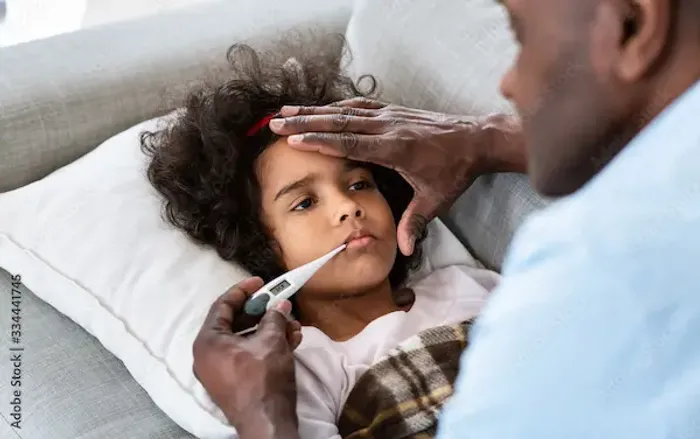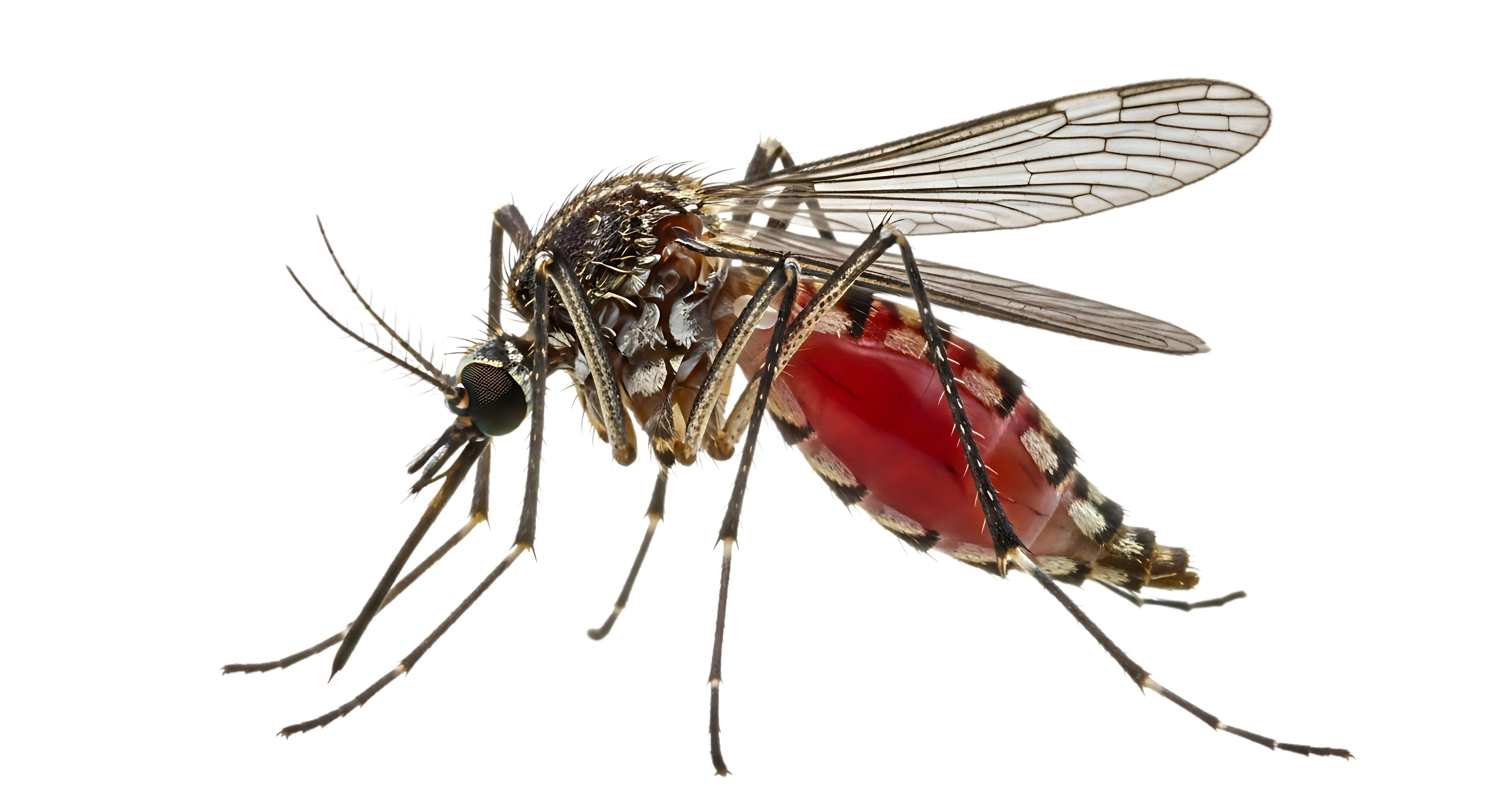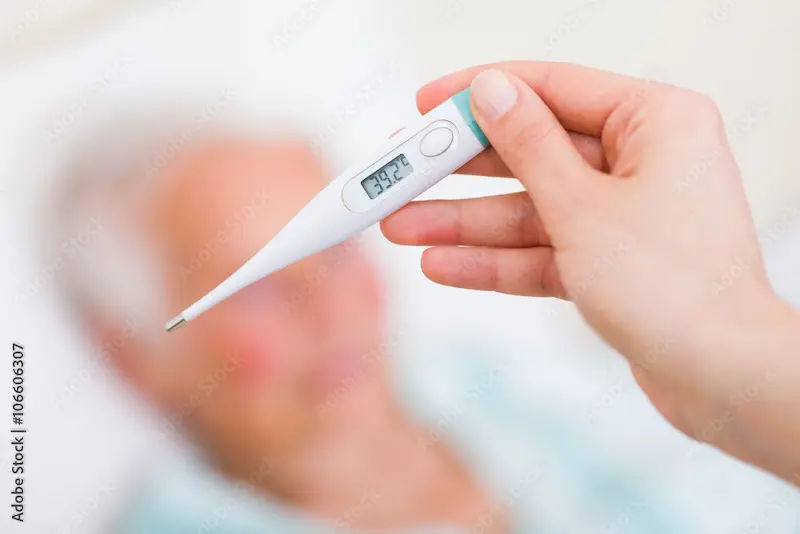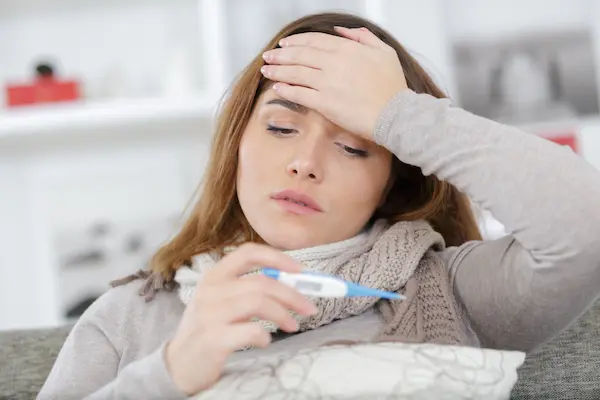Guide to Fever Children
A complete guide for parents on managing fever in children — understand causes, temperature ranges, safe home care, warning signs, and when to see a doctor. Includes a practical fever diary and myth-busting facts for calm, confident care.

Written by Dr. Mohammed Kamran
Reviewed by Dr. Rohinipriyanka Pondugula MBBS
Last updated on 28th Oct, 2025

Introduction
Few things worry parents more than a high fever in children. The number on the thermometer can feel alarming, especially at night, yet fever is usually the body’s healthy response to infection. This complete guide explains what truly counts as a fever, how to take your child’s temperature accurately, and the most effective ways to keep them comfortable at home. You’ll learn when fever is a sign of something more serious, and when it’s safe to watch and wait. We also cover special situations—babies and newborns, post-vaccine fevers, febrile seizures—and regional concerns like dengue, malaria, and typhoid. With step-by-step advice, a fever diary template, and myth-busting facts, you’ll feel calmer and more confident the next time your child runs a temperature. If at any point your child’s symptoms worry you, you’ll find clear “red flag” checklists and guidance on when to seek medical help.
Consult a Top General Practitioner for Personalised Advice
What Counts as a Fever in Children?
Understanding what temperature levels mean helps you respond calmly and accurately.
Normal Temperature Ranges by Age
Most children’s normal body temperature ranges from about 36.4–37.4°C (97.5–99.3°F), with small daily variations.
Activity, warm weather, or snug clothing can raise skin temperature without a true fever.
Fever Thresholds (Celsius and Fahrenheit)
In paediatrics, fever is defined as a core temperature of 38.0°C (100.4°F) or higher, measured accurately—rectally in
infants, or orally/tympanically in older children. Axillary readings are lower, so a reading of 37.5–37.8°C suggests fever
but should be confirmed with a more accurate method.
“Fever vs Hot to Touch”: What Matters
A child’s comfort and behaviour are more important than the number alone. A lively child at 39°C is often less
concerning than a drowsy one at 38°C. Teething rarely causes fevers of 38°C or higher—think infection instead.
Why Fever Happens: The Science and Common Causes
Knowing why fevers occur helps parents recognise when it’s normal and when it’s not.
How the Immune System “Sets” a Higher Temperature
Fever is a controlled rise in body temperature caused by immune chemicals (pyrogens) signalling the brain to turn up
the heat. It slows pathogen growth and helps immune cells work better.
Common Viral vs Bacterial Causes
Most fevers in children come from viral infections such as colds, flu, or RSV. Bacterial causes include ear infections,
strep throat, urinary infections, and pneumonia.
Teething, Vaccines, Travel, and Seasonal Factors
Vaccines may cause a mild fever for 24–48 hours—this is normal. Teething causes discomfort, not a significant fever.
Seasonal patterns matter: dengue and malaria rise during monsoon months, while influenza peaks in winter.
How to Take Your Child’s Temperature Correctly
Accurate temperature readings ensure proper care decisions.
Thermometer Types
Digital rectal thermometers are most accurate in infants. Oral thermometers suit older children. Tympanic (ear) and
temporal (forehead) devices are convenient but can vary in accuracy.
Age-Specific Techniques and Accuracy
Rectal readings are best under 3 months, oral from 4–5 years, and ear readings from 6 months upward. Always follow
manufacturer's instructions carefully.
Recording and Interpreting Results (Fever Diary)
Keep a fever diary with time, temperature, method, symptoms, medicines, and hydration. This helps track patterns and
share information easily with your doctor.
Home Care: Comfort-First Fever Management
Simple steps at home often make the biggest difference to your child’s comfort.
Fluids, Rest, Light Clothing, Room Temperature
Offer water, oral rehydration solution, or breast milk frequently. Dress your child lightly and keep the room cool.
Encourage rest but allow quiet play if they wish.
What Not to Do (Alcohol Rubs, Cold Baths)
Avoid alcohol rubs or cold baths—they cause shivering and discomfort. Tepid sponging is rarely necessary unless your
child enjoys it.
Eating and Activity: Let Your Child Lead
Appetite may dip during illness; offer small, soft meals and focus on hydration instead.
Medicines for Fever: Paracetamol and Ibuprofen Safely
The right dose at the right time keeps your child safe and comfortable.
Weight-Based Dosing and Maximum Daily Limits
Dose by weight: paracetamol 10–15 mg/kg every 4–6 hours, ibuprofen 10 mg/kg every 6–8 hours. Never exceed
recommended daily totals.
When to Use, When to Skip, and Alternating Myths
Give medicine for discomfort or pain, not just to lower a number. Alternating paracetamol and ibuprofen is not
routinely recommended.
Special Cautions (Asthma, Dehydration, Liver/Kidney Issues)
Avoid ibuprofen in dehydrated or vomiting children and use paracetamol cautiously if liver issues exist. Never give
aspirin to children.
When to Worry: Red Flags and When to See a Doctor
Recognising warning signs early can be life-saving.
Age-Specific Thresholds
Babies under 3 months with 38°C or higher should see a doctor immediately. For 3–6 months, seek help at 39°C or
above, or if your child looks unwell.
NICE “Traffic Light” Style Warning Signs
Watch for difficulty breathing, bluish lips, persistent vomiting, seizures, severe lethargy, dehydration, or non-blanching
rashes.
How Long Is Too Long? Persistent and Recurrent Fevers
Fevers lasting beyond three days or recurring after improvement should be assessed by a doctor.
Special Situations: Babies, Vaccines, Teething, and Febrile Seizures
Certain circumstances need special care and quick action.
Newborns and Young Infants
Any fever under 3 months requires prompt medical evaluation.
Post-Vaccine Fevers and Comfort Care
A mild fever after vaccination is normal; treat for comfort with fluids and paracetamol if needed.
Teething Myths
Teething causes drooling and irritability, but not a true fever above 38°C.
Febrile Seizures: What to Do and Prevention Myths
If a seizure occurs, lay your child on their side, don’t put anything in their mouth, and call emergency services if it lasts
over five minutes.
Tropical Infections and Travel: Dengue, Malaria, Typhoid
In tropical regions, fever may point to specific infections that need testing.
When to Suspect Dengue and Warning Signs
High fever, rash, eye pain, muscle aches, or mild bleeding may suggest dengue. Seek urgent care for abdominal pain,
vomiting, or bleeding.
Malaria Patterns and Urgent Testing
Cyclical fevers with chills after mosquito exposure require same-day malaria testing.
Travel and Exposure History
Doctors will ask about travel, mosquito exposure, or unsafe water. Mention these during consultations.
Tests and Diagnosis: When Labs Are Needed
Not every fever needs tests—your doctor decides based on age and symptoms.
Common Tests
Urine tests, blood counts, CRP, or rapid tests for flu, dengue, or malaria may be ordered depending on your child’s
symptoms.
Imaging and Specialist Referrals
X-rays or ultrasounds may be needed for chest or abdominal concerns.
Home Collection and Telehealth Options
If travel is difficult, use services that offer home sample collection and online doctor consultations.
Preventing Spread and Helping Recovery
Simple hygiene and recovery habits reduce illness in families.
Hygiene, Masks When Sick, Ventilation
Encourage handwashing, use masks when coughing, and ensure good airflow at home.
Return-to-School/Daycare Decisions
Return once your child has been fever-free for 24 hours without medication and feels well enough.
Nutrition During and After Illness
Offer soups, fruit, and yoghurt to restore energy; consider probiotics after diarrhoeal illness.
Myths vs Facts: Debunking Common Fever Beliefs
Clearing up misconceptions helps parents act wisely.
High Numbers and Brain Damage Myths
Typical fevers up to 40°C do not cause brain damage—only extreme heat from the environment can.
Teething and “Onion Socks” or Alcohol Rubs
These remedies are ineffective and potentially unsafe.
“Breaking” the Fever vs Supporting the Child
Focus on comfort and hydration, not chasing a “normal” temperature.
A Practical Step-by-Step Plan During a Fever
Follow this simple timeline to stay calm and organised.
First Hour: Assess and Comfort
Measure temperature, observe behaviour, offer fluids, and record readings.
Next 24 Hours: Monitor and Record
Track temperature, medicines, and hydration every few hours; note any red flags.
Day 2–3: Reassess and When to Escalate
If the fever persists beyond 72 hours or symptoms worsen, consult a doctor.
Creating a Simple Fever Diary and Action Plan
Recording details helps doctors diagnose more efficiently.
What to Track
Note time, temperature, symptoms, medication, and hydration.
Sharing with Your Doctor
A clear record can shorten visits and prevent unnecessary tests.
Digital Tools and Alerts
Use apps or reminders for medicine timing and shared caregiver access.
For Caregivers: Managing Anxiety and Fever Phobia
Understanding what matters most keeps parents calm and effective.
Behaviour-Over-Number Mindset
If your child is hydrated, alert, and comfortable, you’re managing well—even at 39°C.
Scripts for Daycare/School Communication
Inform caregivers clearly when your child returns after illness.
Preparing a “Fever Kit” at Home
Keep a thermometer, dosing syringe, paracetamol, ibuprofen, ORS, and emergency contacts ready.
Conclusion
Fever in children is common—and usually a sign that the immune system is working. Focus on hydration, comfort, and
your child’s behaviour rather than the thermometer reading. Use accurate techniques, dose medicines safely, and keep a
simple fever diary for trends. Be extra cautious with young infants and act quickly if red flags appear, such as breathing
difficulty, dehydration, or rash. In tropical areas, early dengue or malaria testing is crucial. Most fevers resolve within a
few days, but if they persist or recur, seek medical advice promptly. With calm observation, informed action, and trusted professional guidance, you can manage fever safely and confidently at home.
Consult a Top General Practitioner for Personalised Advice
Consult a Top General Practitioner for Personalised Advice

Dr Syed Mateen Pasha
General Physician
2 Years • MBBS
Bengaluru
PRESTIGE SHANTHINIKETAN - SOCIETY CLINIC, Bengaluru

Dr. Vivek D
General Physician
4 Years • MBBS
Bengaluru
PRESTIGE SHANTHINIKETAN - SOCIETY CLINIC, Bengaluru

Dr. Syed Ismail Ali
General Practitioner
7 Years • MBBS
Hyderabad
Apollo 24|7 Clinic, Hyderabad

Dr. Anand Ravi
General Physician
2 Years • MBBS
Bengaluru
PRESTIGE SHANTHINIKETAN - SOCIETY CLINIC, Bengaluru

Dr. Johnson. S
General Practitioner
7 Years • MBBS MD(Preventive and social Medicine)
Pune
Apollo Clinic, Nigdi, Pune
Consult a Top General Practitioner for Personalised Advice

Dr Syed Mateen Pasha
General Physician
2 Years • MBBS
Bengaluru
PRESTIGE SHANTHINIKETAN - SOCIETY CLINIC, Bengaluru

Dr. Vivek D
General Physician
4 Years • MBBS
Bengaluru
PRESTIGE SHANTHINIKETAN - SOCIETY CLINIC, Bengaluru

Dr. Syed Ismail Ali
General Practitioner
7 Years • MBBS
Hyderabad
Apollo 24|7 Clinic, Hyderabad

Dr. Anand Ravi
General Physician
2 Years • MBBS
Bengaluru
PRESTIGE SHANTHINIKETAN - SOCIETY CLINIC, Bengaluru

Dr. Johnson. S
General Practitioner
7 Years • MBBS MD(Preventive and social Medicine)
Pune
Apollo Clinic, Nigdi, Pune
More articles from Fever
Frequently Asked Questions
1) Does teething cause fever in babies?
Teething may cause mild discomfort and warmth, but a true fever (≥38°C) usually means infection.
2) Should I alternate paracetamol and ibuprofen for my child’s fever?
Not routinely. Alternating can cause dosing errors. Use one medicine correctly unless advised otherwise.
3) When should I take my child to the doctor for a fever?
Immediately for babies under 3 months with ≥38°C, or for any child with red flags such as breathing trouble or dehydration.
4) What temperature is considered “high” in children?
38.0°C (100.4°F) is fever; 39.0°C (102.2°F) is moderate; 40.0°C (104°F) is high—but how your child acts matters more.
5) Can I bathe my child during a fever?
Yes, a lukewarm bath can soothe. Avoid cold baths or alcohol rubs, which may cause shivering.




